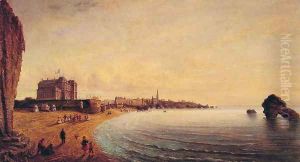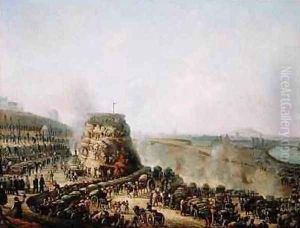Louis Moullin Paintings
Louis-Alexandre Moullin, often known simply as Louis Moullin, was a French painter born on October 19, 1849, in Paris, France. He is known for his works in genres such as landscapes, still lifes, and portraits, particularly for his attention to the play of light and shadow.
Moullin began his artistic education at the École des Beaux-Arts in Paris under the tutelage of Alexandre Cabanel, a well-regarded academic painter of the era. He also studied with Jean-Léon Gérôme, another prominent figure in 19th-century French art, known for his neoclassical and Orientalist subjects.
During his career, Moullin exhibited at the Paris Salon, an official art exhibition of the Académie des Beaux-Arts in Paris. The Salon was the definitive annual event for artists to showcase their work and gain recognition. Moullin's participation in these exhibitions helped to establish his reputation as a capable and skilled artist of his time. His works were appreciated for their detail, composition, and use of color.
While Moullin's work can be associated with the academic style of painting due to his education and the era he lived in, he also experienced the transition to Impressionism and the various art movements that emerged at the end of the 19th century and the beginning of the 20th. Despite these changes in the artistic landscape, Moullin remained relatively traditional in his approach to painting.
Not much is known about Moullin's personal life or the breadth of his oeuvre, as he does not rank among the most famous artists of his time. However, his contribution to French art during the period is recognized by those who study the period and appreciate the lesser-known artists of the era.
Louis Moullin's death occurred on December 29, 1924, in Paris. While he may not have achieved the same level of fame as some of his contemporaries, his works remain part of the broader narrative of French art history and exemplify the style and techniques of late 19th-century academic painting.


